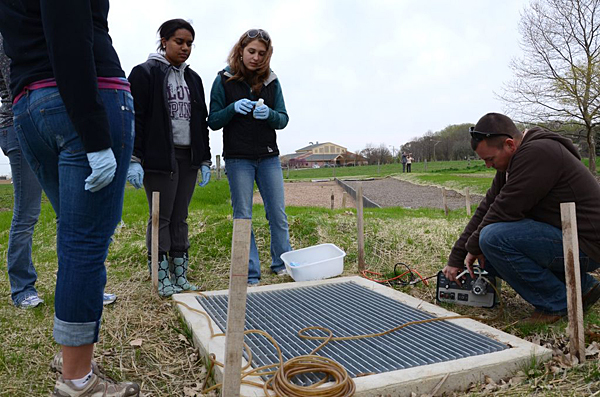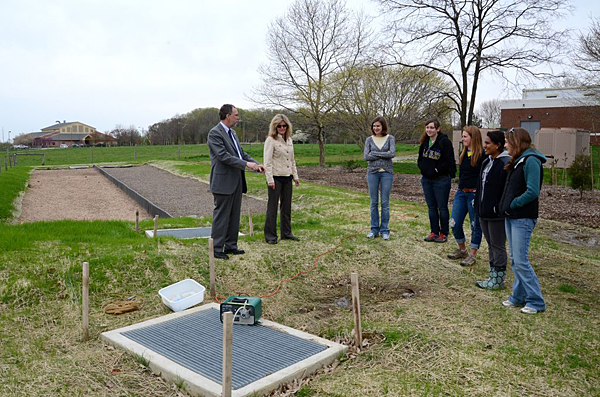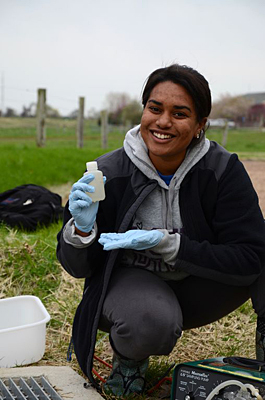Stormwater runoff
CANR fights stormwater runoff to help White Clay Creek
11:38 a.m., May 17, 2011--After the storm has passed, the damage isn’t done. In fact, for White Clay Creek, the destruction is just beginning.
Much of the University of Delaware's campus, including the College of Agriculture and Natural Resources (CANR) farm, drains into Cool Run, a tributary of White Clay Creek. Because the creek has been designated as a National Wild and Scenic River, a designation spearhead by Vice President Joseph R. Biden, Jr., a UD alumnus, the University now has the distinction of being one of only two universities in the country to have a National Wild and Scenic River run through its campus. Because of this, there is an urgency to quell the impact of stormwater runoff into the creek.
Campus Stories
From graduates, faculty
Doctoral hooding
Stormwater runoff, unfiltered water that reaches bodies of water by flowing across impervious surfaces, enters White Clay Creek through multiple sources throughout the city of Newark and the UD campus. Because of this, CANR has teamed with partners from across the University and the city to see what can be done to help reduce the University’s contribution to the problem, activity that has led to the formation of the University of Delaware Watershed Action Team for Ecological Restoration (UD WATER).
UD WATER is led by Tom Sims, deputy dean of the college and the T.A. Baker Professor of Soil and Environmental Chemistry, and Gerald Kauffman, state water coordinator and director of the Water Resources Agency, a unit of the Institute for Public Administration. It includes faculty members from the University as well as members from the city and the Delaware Geological Survey and UD student interns.
In addition to many other projects undertaken on the CANR farm to stop stormwater pollutants from reaching White Clay Creek, the UD WATER team decided another step to curb stormwater runoff was to create a biological filtration system on the CANR campus.
Jennifer Pyle, environmental health specialist in charge of the UD stormwater management program, explained, “Since the rainwater runoff from our campus and the UD farm ultimately ends up in White Clay Creek, biofiltration systems are a way to treat the runoff and help remove pollutants prior to reaching the creek.”
Pyle said that removing the pollutants is beneficial not only for fish, aquatic vegetation and other organisms in White Clay Creek but also for the city's drinking water supply. Because much of the city’s drinking water comes from White Clay Creek, “the fewer pollutants that have to be removed during the water treatment process makes the water cleaner and cheaper," she said.
Pyle noted that “every effort made to increase the quality of the stormwater and reduce the quantity of the stormwater is beneficial to White Clay Creek.”
For the location of the biological filtration system on the CANR campus, the area by Fischer Greenhouse was chosen because it has several storm drains that come together in a central location prior to discharging into the Cool Run tributary of White Clay Creek. These storm drains collect runoff from Worrilow Hall, some of the streets and parking lots in that area and the CANR farm.
Jenny McDermott, facilities manager at CANR, explained that when the college complex was originally constructed there was simply a storm drain system with no stormwater protections.
McDermott said the intent of the biological filtration system is “to both filter and infiltrate, meaning stormwater pollutants are filtered out of the water and the water is then retained temporarily, allowing it to soak down into the ground and recharge groundwater supplies.”
With the old system in place, the stormwater runoff would simply go through a storm grate, through pipes, and eventually end up in White Clay Creek.
Now, with the new system, the stormwater will be funneled into the biological filtration system for treatment before entering White Clay Creek.
The system has two rectangular areas that are situated side by side and are designed to act as a combination biological and chemical filter, taking pollutants from the water. One area is comprised of sand, peat moss and mulch. The other is comprised of modified media, designed by Bill Lucas, a principal in Integrated Land Management Inc.
McDermott said that unlike normal soils around Delaware, this alternative media “is a mix of sand, water treatment residuals, and other organic materials intended to increase removal of dissolved nutrients and bacteria in addition to the total suspended solids, particulate nutrients, hydrocarbons, and heavy metals. The outlet system is also specially designed to improve plant uptake.”
There are two catchments located at the back of the two rectangular areas so that student interns can analyze the runoff to determine the effectiveness of the two different types of filtration types and what types of nutrients, pathogens and total suspended solids are being prevented from running into White Clay Creek.
The area will eventually be planted with vegetation, which not only will help in retaining stormwater runoff and nutrient update but will blend aesthetically with the surrounding landscape, because it will be planted with a range of vegetation adapted to wet-dry cycles.
The new biological filtration system was made possible by a $60,000 grant from the Clean Water Advisory Council’s Community Water Quality Improvement Grant Program within the Delaware Department of Natural Resources and Environmental Control (DNREC).
Sims said "CANR is grateful to DNREC and to its partners at UD and in the city for their ongoing efforts to install ecologically based stormwater mitigation practices that both protect the White Clay Creek and provide educational and research opportunities for our students."
Article by Adam Thomas
Photos by Danielle Quigley













